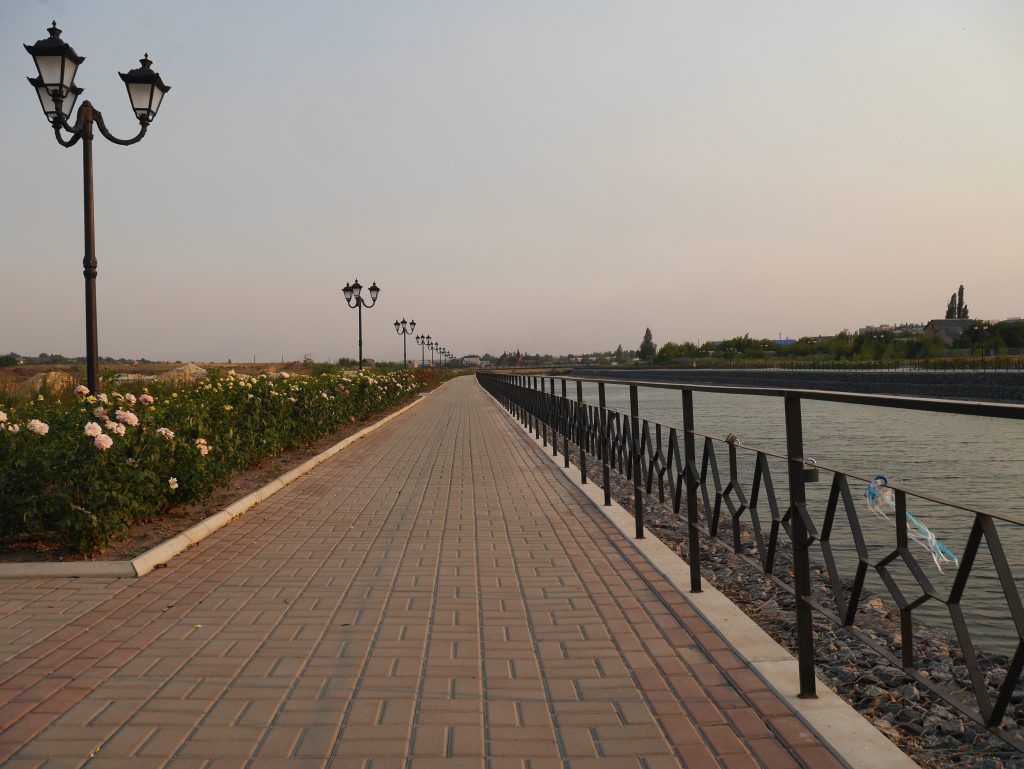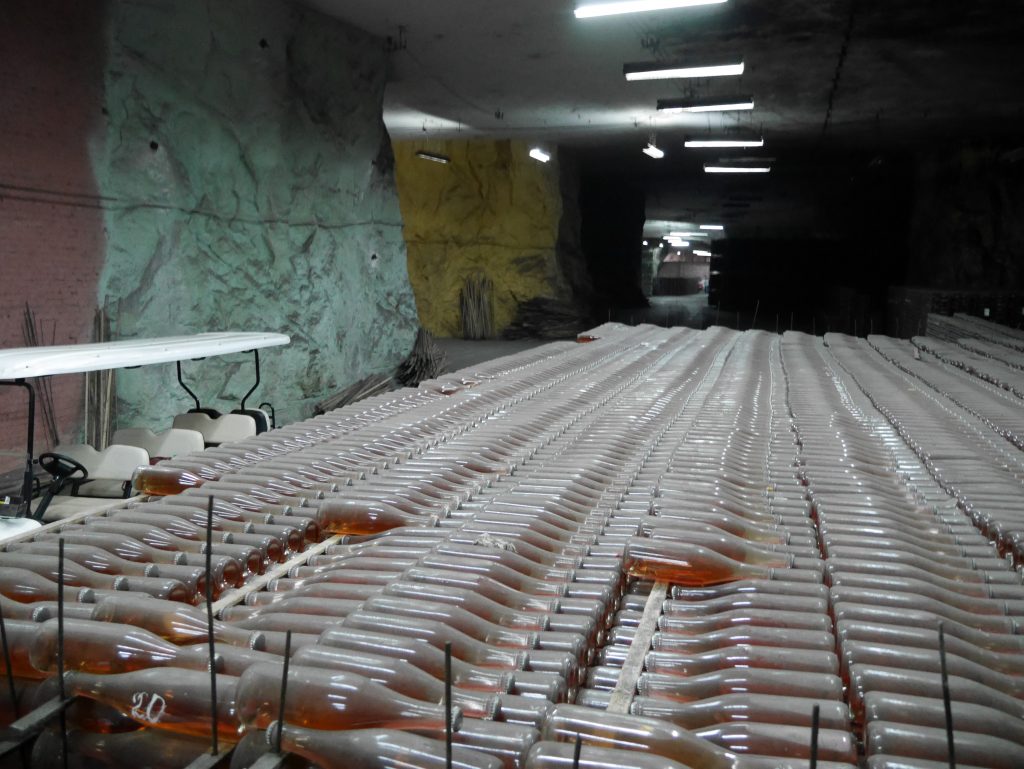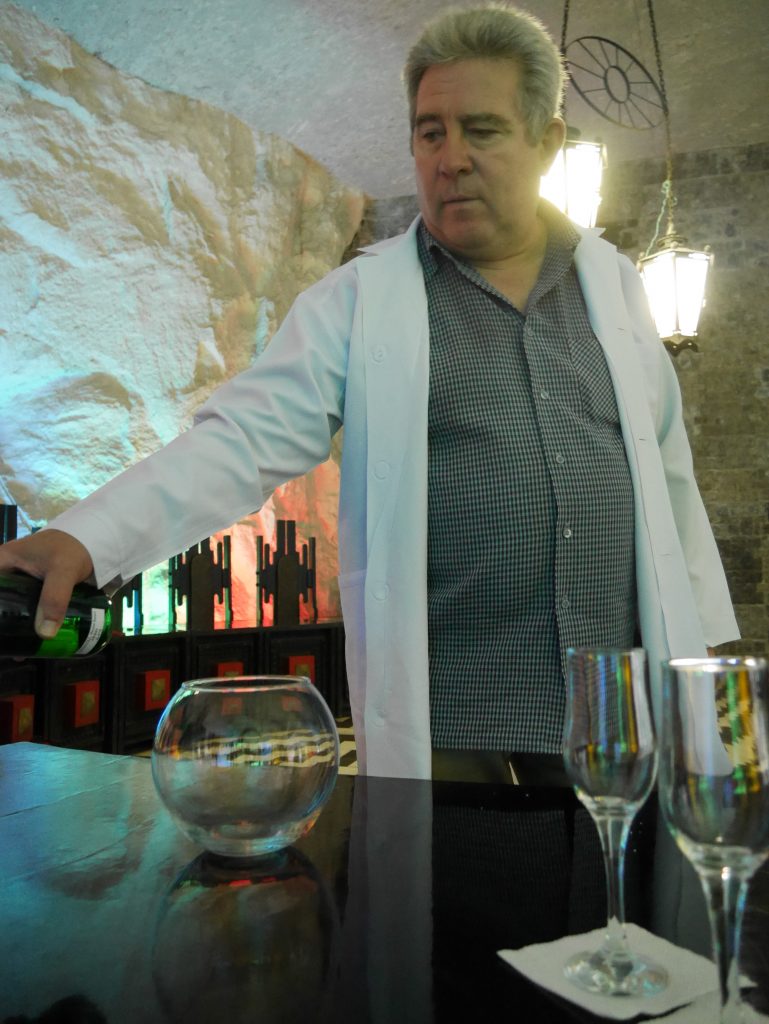
Posh shops and boutiques are located on the main street of Kyiv in a Centralnyj Uniwersalnyj Magazin (a large department store), renovated by Rinat Akhmetov, the wealthiest Ukrainian. It is a kind of an island of luxury, where many Kyiv residents and guests come just to have a walk because it’s Centralnyj Uniwersalnyj Magazin! There is a terrace on the top floor with a clear view of the
If one talks about alcohol and Ukraine, it is usually about vodka, sometimes cognac or wine, but sparkling wine, something like French champagne? Really? There are many wine producers in Ukraine – generally in the south, in Odessa Oblast, Kherson Oblast, Mykolaiv Oblast and Zakarpattia Oblast. They are all large post-Soviet producers and new private vineyards. One can argue about the quality of the produced wine. Some wines are better than others. However, interestingly, there are several producers of a sparkling wine, which even a dozen or so years ago was often called “champagne” in post-Soviet countries.
Polish people still drink a “Sovetskoye Igristoye”, especially on New Year’s Eve. Besides, it is produced in Poland. Probably the primary function of “Sovetskoye Igristoye” is to shoot out and make some noise when one opens the bottle, as it is a cheap wine product once associated with the USSR (it is called “Sovetskoye Shampanskoye” as well).
There are different kinds of sparkling wines, and it is all about the production process. The name “champagne” is reserved exclusively for wines which come from the Champagne region of France. The local sparkling wines are made according to a traditional method, which has different stages. One of the most important of them is secondary fermentation of the wine in the bottles to create carbonation (creating bubbles). The whole process of making champagne can last from nine months to several years. Although the same method is used outside of Champagne, one cannot call those sparkling wines true champagne.
The traditional method is expensive and time-consuming, so currently, the majority of sparkling wines are produced using the Charmat method – the process of secondary fermentation takes place in large closed pressure tanks. First of all – it reduces costs and production time because it takes 15 to 20 days to get the bubbles. For example, prosecco is made using the Charmat method.
What is known in Poland as “Sovetskoye Igristoye” is often produced like soda or rather an alcopop and has nothing to do with real sparkling wine. In Ukraine, sparkling wine named “Sovetskoye” was until recently also one of the most popular. Generally, it remains popular, but the name has slightly changed. It was connected with the consequence of the de-Communization law adopted in 2015. Kiev Champagne Winery changed the name of the produced liquor into “Sovetskoye Shampanskoye”. The graphic layout remained unchanged. There are also much more noble beverages under this name, including dry sparkling wine.
In Ukraine, sparkling wines are produced in Kyiv, Odessa
However, the largest producer of sparkling wines, not only in Ukraine but throughout Eastern Europe, is the Artwinery company, formerly known as Artemivsk Champagne Wines Establishments. Interestingly, it is located in the city of Bakhmut (formerly known as Artemivsk) in Donbas – a region commonly associated with mines and heavy industry.
Clay, salt … and wine
77.000 people live in Bakhmut in the Donetsk Oblast. The city is located 67 kilometres in a straight line from Donetsk. Bakhmut was founded by the Cossacks at the turn of the 18th century and became an important industrial centre mainly due to coal seams nearby, and, most of all, salt and gypsum deposits. Bakhmut was even more industrially important during the industrialisation of the Soviet Union. At the beginning of the 1920s, Bakhmut was the administrative centre of the Donets Governorate. The city changed its name into Artemivsk in 1925 in honour of the local revolutionary Fyodor Andreyevich Sergeyev, better known as Comrade Artyom.
Until today, Bakhmut is an important industrial centre. In a located nearby Soledar there is one of the biggest mining salt companies – “ARTEMSIL”. Clay is also mined here. In 2006, the French company Lafarge opened a factory in Bakhmut producing plasterboard and gypsum. Besides, in the 1950s, Stalin ordered to establish a company producing sparkling wines – the largest in the USSR and one of the largest in Europe. Until 2014, Bachmut was a small, peaceful and prosperous city, especially taking into consideration Ukrainian conditions. A low, typical Stalinist architecture dominates the centre – and it must be admitted that it does not look so bad.
Everything changed in 2014 when the so-called Russian Spring came to Donbas. In April 2014, armed fighters came from Russia to Sloviansk, which is located 45 km from Bakhmut. The war in Donbas started. Pro-Russian separatists announced the rise of the Donetsk People’s Republic in the city and the whole Oblast. In Bakhmut, (called Artemivsk back then), there was an important target for separatists and militants — the centre of securing military technology and small arms. To put it simply — a huge warehouse of military equipment. Militants attempted assaults five times — without any result.
Eventually, the city was liberated on July 6, 2014, by the Ukrainian army. However, military operations in nearby areas took place throughout the summer of 2014. The city became an important
Regardless, the Artemivsk Champagne Wines Establishments company did not cease the manufacture even for a day in 2014. To this day Bakhmut remains in the immediate proximity of the demarcation line.
Stalin approved it
The Artwinery buildings located on the ground are not anything special — everything changes when we enter the premises. We drive in an electric car — the road goes underground because the majority of the factory buildings is located there. Artwinery’s buildings occupy 16 hectares on the ground and 25 hectares underground.

Why are the factories producing sparkling wines located in the Donbass, where there are no vineyards? To clear things up, we have to go back to the post-war period and USSR planned economy or even further.
Gypsum was mined here between the years 1880-1890. Mining is being continued until today nearby. After World War II, countries which formed the Nazi coalition (Hungary, Bulgaria and Romania) settled accounts with the USSR as part of war reparations in various ways. For example, wine and cognac were being sent to USSR, initially to the locality of Solidar near Bakhmut. There were empty adits there because of earlier salt mining. It was convenient because railway tracks were going there, but the environment of the tunnels was too aggressive for wine — the hoops of barrels begun to rust because of the presence of salt. That is why the tunnels made during the mining of gypsum in Artemivsk were examined, and in February 1950 a decision was made about locating the wine warehouses there.
Conditions for storing wine appeared to be good, and the managers of the wine warehouses managed to convince the then People’s Commissar of the food industry to build facilities producing sparkling wines. The decision to establish the Artemivsk Champagne Wines Establishments was signed at the end of June 1950 by Joseph Stalin himself. In 1965, the construction was completed, but the first wines were produced here in 1954, in the amount of 460,000 bottles. In 1965, 5 million bottles of Soviet champagne were produced here.
After some upgrading in recent years, a production capacity of 25 million bottles per year was assumed. In 2013, more than 19 million bottles of wine were produced – the most significant number in a single year and then the war destroyed the whole plan. As a result, the production dropped to about 11 million bottles per year. For comparison, the New World company in the Crimea, which also produces sparkling wines using the classic method, was making up to 5 million bottles of sparkling wine per year.
We are going deep to the adits; there are places where only the headlights of our electric cart light up the darkness. Yuri Korolev, Artwinery guide is driving the car. He knows everything about the history of the local plant, and about the production of sparkling wine. Other employees say: “Yuri protects the history of our factory”. Also, he is a great story-teller.
Why the gypsum workings turned out to be a perfect place for the production of sparkling wines? – Gypsum maintains a constant temperature in summer and winter – approx. 13-15 °C and ensures adequate humidity. Thus, climate conditions are similar to those in Champagne.
– We are in the first premises – the wine materials. We buy wine in the Odessa Oblast, Kherson Oblast and Mykolaiv Oblast. Until 2015, we were buying it in the Crimea. We also had our viticulture there, but it was taken from us during the annexation of Crimea by Russia. If the word “Crimea” appears in the name of our wine, it means that there are mixed Crimean wines. In 2015, we bought a massive consignment of wine from Crimea (because the quality was good). At the beginning of 2017, we also bottled wine from the Crimea. It means that for several years, our customers will be able to buy a Crimean brut that is aged for three years – says Korolev.
It feels like in Champagne
The wine is delivered in cisterns to the plant. Its quality is checked on the surface. The chemical composition is examined in the laboratory; the microbiological and organoleptic analysis is carried out – the aroma and the bouquet of flavours. Later the wine is pumped into the tanks. Then the product is being cleaned – appropriate substances are added, and the wine is left for 20 days. As technologists say – this stage means the clarification of wine. Also, after 20 days the wine is filtered.
– We buy devices in Germany, France and Italy. We started in the late 1970s, and we have already changed them several times. The last automation of the production process took place between 2008-2012. We planned to reach the level of 25 million bottles a year, and modern machines were needed. We have changed, for example, tanks and filters. After the filtration, wine is pressed into the premises where the coupage is made, and then the assemblage is made, i.e. mixing the wine. We use French terms for different stages of wine production, just like in France – our guide is telling his story.
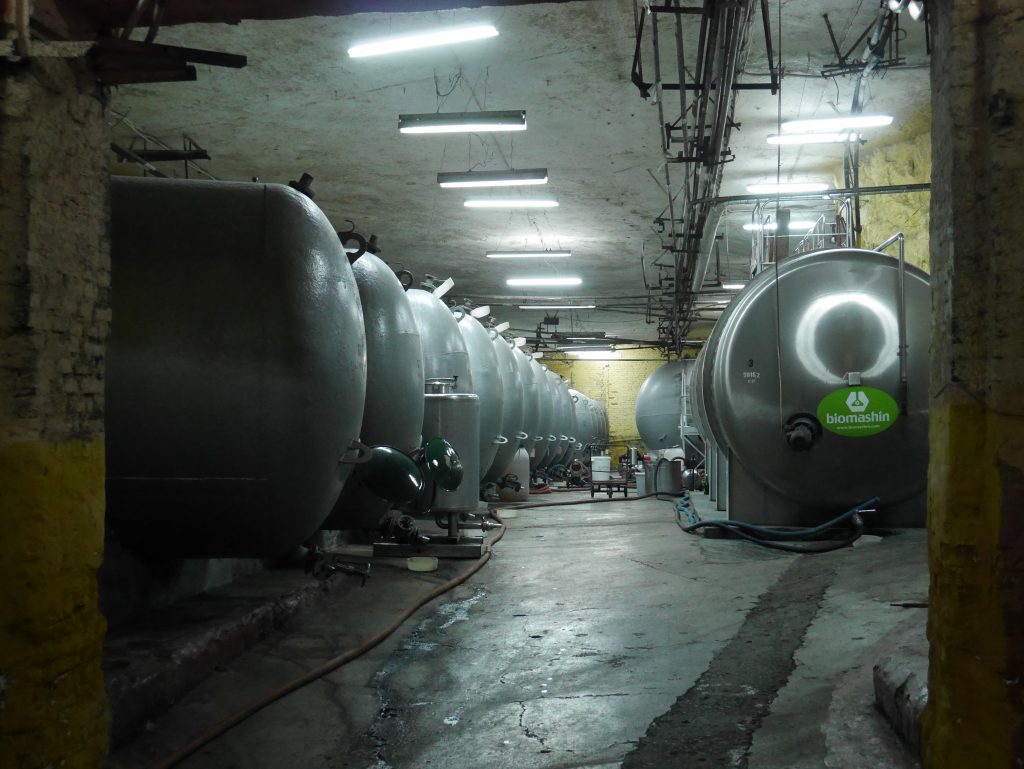
Young wines are used to create the
When it comes to the subject of bottles for sparkling wine, it is not so simple either. They are produced in Dnipropetrovsk Oblast, and they need to be of adequate strength. Eight bottles are selected from each pallet to test their quality. Within a minute, the bottle should withstand a pressure of 17 atmospheres. The bottles are used once and must endure three years of storing wine. During that time the glass structure changes because of the internal pressure.

The bottles are filled with a blend of wine – coupage, liqueur and yeast. Yeast play a decisive role in the further stage of making sparkling wine. The wine is bottled temporarily. In the next premises, wine is subject to the process of secondary fermentation, which results in the carbonation of wine. It happens naturally in bottles, as in the case of French champagne. Also, that’s what distinguishes Artwinery from most other sparkling wine producers.
In Ukraine, sparkling wines were produced according to this “champagne method” only in “New World” company in the Crimea. The Shabo company has also begun to produce them lately, but most of its sparkling wines are created using the Charmat method. In Bakhmut, all wines are subjected to the process of carbonisation in the bottles. That’s the way it has always been. The most crucial stage is the one when the wines are put in a particular way, allowing the bottles to be moved. Each bottle is moved several times during ageing.
– Active yeasting fermentation takes place inside the bottle during the first two months. Yeasts react with carbohydrates. As a result, gas is released which saturates the wine with carbon dioxide. That is how the classic bottled production method looks like. Everything is done naturally, we do not interfere in the process. The reaction stops, and you have to move the bottle properly to start it up again. It is also about not letting the wine lees stick to the walls of the bottle. The aim is to keep it in a suspended condition. What is more, moving the bottle is also checking its endurance – Korolev describes the whole process.
The process is partly automated, but the position of most bottles is still changed using hands. It takes place in the largest part of the entire plant – its area occupies 9 out of 29 underground hectares. The wines are
– It is all about moving the wine lees into the temporary bottle cork. It lasts about two months. During that time the wine should become crystal clear, and the entire wine lees should be found in this temporary cork – says the guide.
Although 70% of the whole production is automated, including the rotation of bottles, still a significant part of them is rotated using hands.
– It’s hard work. You need to turn around 80,000 bottles – says one of the women working in the Remuage guild.
Women usually turn the bottles. 60% of the 500-person crew are ladies.
– When the French came to us in 2007, they said that we worked according to the Middle Ages methods. All the bottles were being turned using hands back then. Nowadays we use hands to turn the bottles of the most expensive, elite cuvée wines or custom-made products. The rest is up to machines. Unfortunately, our manual labour cannot be valued much higher, as it should be, as it is in France – adds Korolev.
Slowly, however, the changes come – vending machines installed by the French already rotate some of the wines. The whole process is quicker and takes about two weeks.
In other premises, one needs to get rid of the wine lees. The bottles of wine are dipped upside down to a depth of 5-7 cm in a unique solution at a temperature of -25 ° C for 13-15 minutes. The lees freeze. Then the bottles go to a particular machine, where the temporary cork is removed, and the lees flow out under pressure. French champagne specialists calculated it. About 1.5 atmospheres escape from the bottle.

A liqueur is added to wine in another machine. It depends on the type of wine: brut, extra brut, semi-dry, semi-sweet. Only the kind of wine called Krimart Zero (a brut) does not contain liqueur.
– Later the machine inserts the corks. For seven years we have been using only a natural cork that we import from Portugal – the guide notes.
After that, the wine bottles are put under control. They are ageing for minimum 15 days because liqueur must fully assimilate with wine. Finally, the metal stoppers and labels are applied. The wine is ready.
The only one in Europe
– There are no such plants in Europe. The largest champagne manufacturer in France, Moët & Chandon, which produces up to 30 million bottles a year, is not localised in one place. They are several connected smaller plants – Korolev says, and he is so proud about Artwinery.
We pass a large face carved in plaster – it was created naturally, only its eyes were cut by a human hand. That is how the guardian of the local wine appeared – the local Bacchus. Next to the face, the wine is leaking. Apparently, a bottle broke during the process of carbonisation.
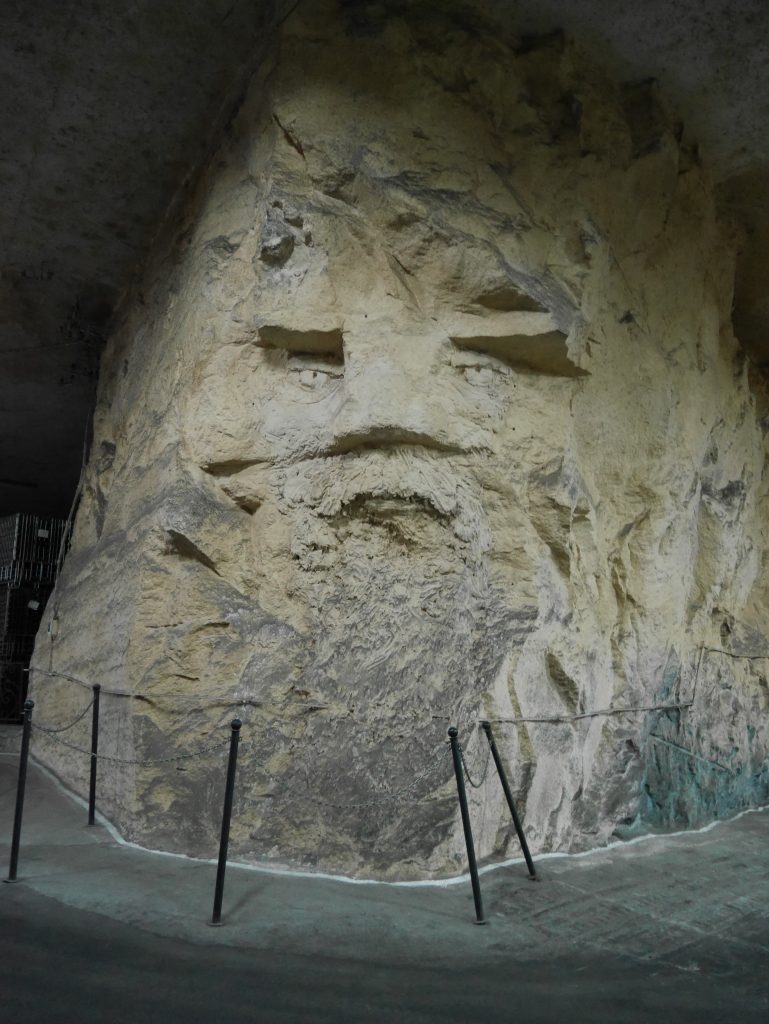
We reach the so-called throne room, located 75 metres underground. There are massive, weighing several dozen kilograms tables standing next to the walls. This room was built for Soviet leadership — the First Secretaries of the Central Committee of the Communist Party of Ukraine: Petro Shelest and Volodymyr Shcherbytsky, as well as the Presidents of independent Ukraine: Leonid Kuchma and Viktor Yanukovych. It is a VIP tasting room.
The pride of the company is brut zero – a wine without sucrose or liqueur.
– We were the first to produce brut in Eastern Europe without adding sugar. They did not do it in the Crimea, nor in Russia or Moldova – emphasises Korolev.
– Krimart brut zero was a very ambitious project for our specialists. They cooperated with vine growers from Crimea for a long time to create proper coupages, from which you can make sparkling wine without adding sugar. Only natural composition – this is how a gourmet drink was created – says Julia Vodolazkina who works for Artwinery press office.
The popular series of light sparkling charte wines is a publicity stunt; the employees admit – the first two letters come from the word “champagne” written in French and the others from the name “Artemiwsk”. Anyway, the word “champagne” disappeared from the labels in 2006.
– We respect European Union legislation, and the name “champagne” is reserved for wines produced in Champagne in France. In 2006, we also quit the name “Sovetskoye”. So, we went through the process of de-Communization quite long ago – Vodolazkina laughs.
You can taste the sparkling wine from Bakhmut in Kyiv in the company’s bars. A great success was the opening of such bar in 2014 at the airport in Donetsk. The local Charte Bar was very popular. Soon, however, the airport was turned into a battlefield.
Poland does not import the wines from Bakhmut. However, Poland was among one of the first countries to import “Sovetskoye Shampanskoye” from Artemivsk. Currently, the wine is sent to many countries, and the website has its Chinese language version, but export accounts for only 15% of production.

– It is difficult to find your place in the market, especially in the West, where the tradition of sparkling wine production is over 300 years old – our interlocutors admit.



